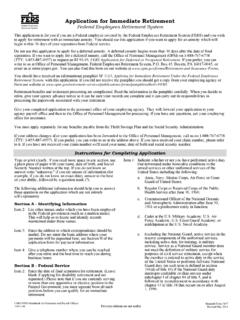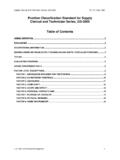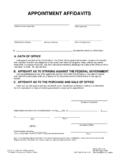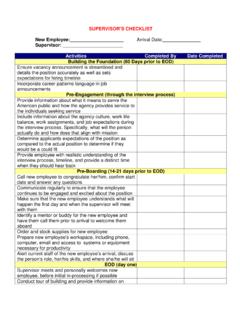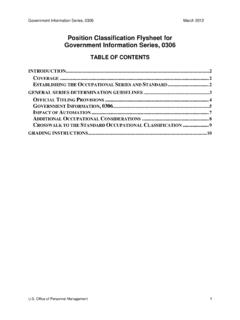Transcription of Federal Wage System Job Grading Standard for Aircraft ...
1 Aircraft Mechanic, 8852 HRCD-6 January 1999 Federal wage System Job Grading Standard for Aircraft Mechanic, 8852 Table of Contents WORK WORK NOT GRADE HELPER AND INTERMEDIATE NOTES TO Aircraft WORKER, GRADE Aircraft MECHANIC, GRADE Aircraft MECHANIC, GRADE Office of Personnel Management 1 Aircraft Mechanic, 8852 HRCD-6 January 1999 WORK COVERED This Standard is used to grade all nonsupervisory jobs involved in the maintenance, troubleshooting, repair, overhaul, and modification of fixed and rotary wing Aircraft systems, airframes, components and assemblies, where the work requires substantive knowledge of the airframe and Aircraft mechanical, pneudraulic, and/or electrical systems and their interrelationships. Some work situations within this series may require varying levels of electronics knowledge.
2 This Standard cancels and supersedes the Job Grading Standard for Aircraft Mechanic, 8852, issued February 1969. WORK NOT COVERED This Standard does not cover work that primarily involves: - Maintenance, troubleshooting, repair, overhaul, and modification of Aircraft engines. (See Job Grading Standard for Aircraft Engine Mechanic, 8602.) - Maintenance and repair of hydraulic, pneumatic, oxygen, or fuel systems. (See Fluid Systems Maintenance Job Family, 8200.) - Repair, maintenance, modification, test, and calibration of mechanical, electrical, and pneumatic instruments, flight and engine instruments, and instrument systems. (See Job Grading Standard for Instrument Mechanic, 3359.) - Refueling and servicing Aircraft . (See Job Grading Standard for Aircraft Attending, 8862.)
3 - Repair, maintenance, modification, or overhaul of Aircraft mechanical parts, components, subassemblies, or assemblies removed from the Aircraft , which does not require a substantive knowledge of Aircraft systems and their interrelationships. (See Aircraft Mechanical Parts Repairing, 8840.) - Fabrication, modification, repair, assembly, and installation of Aircraft sheet metal items. (See Sheet Metal Mechanic, 3806.) - Maintenance, troubleshooting, repair, overhaul, and modification of Aircraft electrical systems or of Aircraft electronic systems. (See Job Grading Standard for Aircraft Electrician, 2892, or appropriate series in the Electronic Equipment Installation and Maintenance Family, 2600.) - Inspection of repairs done on Aircraft mechanical, electronic, pneumatic, hydraulic, and other systems, components and devices related to Aircraft .
4 (See Job Grading Standard for Inspectors.) Office of Personnel Management 2 Aircraft Mechanic, 8852 HRCD-6 January 1999 - Leading the work of three or more mechanics assigned on a regular basis. (See Job Grading Standard for Leader WL/NL.) TITLES Jobs covered by this Standard below grade 10, other than helper and intermediate jobs, are titled Aircraft Worker. Jobs at grade 10 and above are titled Aircraft Mechanic. GRADE LEVELS This Standard does not describe all possible levels at which jobs might be established. If jobs differ substantially from the level of skill, knowledge, and other work requirements described in this Standard , they may be graded above or below these grades, based on the application of sound job Grading principles. HELPER AND INTERMEDIATE JOBS Helper and intermediate jobs in this series are graded by the Office of Personnel Management Job Grading Standard for Trades Helper and Intermediate Jobs.
5 Grade 10 is to be used as the "journey-level" grade in applying the Intermediate Job Grading Table. Grade 11 is not the "journey-level" grade for this occupation. NOTES TO USERS ! The basic skills and knowledge of Aircraft mechanics are concerned with mechanical, pneudraulic and electrical work on flight controls, engine controls, landing gear, etc. Depending on the assignment, there may be additional skills and knowledge required such as sheet metal, electrical wiring, motors and controls, Aircraft engines, and Aircraft ground support equipment. At the depot level, the work and the knowledge of the overall Aircraft and its systems are very specific and limited to the phase at which the Aircraft is being worked. Typically, the broader skills mix may be found in flight line maintenance or similar operational/flight oriented assignments.
6 The variety of skills employed does not necessarily have grade level significance. ! Typically, work assignments on the smaller, older, or less complex Aircraft that are found in the Federal inventory are characterized by factors such as: great range and depth of repair work; incomplete, out of date, or very general guidelines written for commercial Aircraft ; and fabrication of discontinued parts is required or the installation of newer technology on older systems. Conversely, assignments on the larger or more complex Aircraft are characterized by more varied types of systems involved in flight, radar/GPS, or armament and have more detailed guidelines on when and how work is to be performed. These variations are within the scope of the grade levels described. As a result, the "type" of Aircraft or "variety" of Office of Personnel Management 3 Aircraft Mechanic, 8852 HRCD-6 January 1999 Aircraft worked on are not grade distinguishing characteristics in the application of this Standard .
7 ! As discussed in the Introduction to the Federal wage System , a requirement that employees be licensed or certified to perform work ( , FAA Certification), or that they certify with their signatures that standards of quality and safety have been met in performing work, does not in itself affect the grade level of a job. ! Situations in which the Aircraft mechanic may work with no technical supervision are not grade controlling in themselves. There must be a commensurate increase in responsibility as well as skill and knowledge. Journey-level mechanics are expected to work with a certain amount of independence in all situations. ! Ongoing technological advancements in the field of electronics will continue to have an impact upon electrical components and devices commonly found in the newer, more complex Aircraft covered by this Standard .
8 As a consequence, work within this occupation may require general knowledge of electronic theory and basic troubleshooting techniques. For example, when electromechanical controls have been replaced by electronic-based devices, they may be designed so that adjustment and repair can be done in accordance with detailed instructions for which little electronics knowledge is required. Typically, such work would be graded by the Job Grading Standard for Electronics Mechanic, 2604, at or below grade 8. In other cases, the overall complexity of the unit may be greater due to integration of systems, but the electronic devices are generally part of a self-contained unit that would not exceed the complexity described at the grade 10 level in the 2604 Standard . Only when electronics knowledge is paramount and/or the work involves installing, troubleshooting, maintaining and repairing electronics equipment and complete operational systems of the complexity described at grade 11 level in the 2604 or other appropriate electronics standards , should it be placed in an appropriate electronics series.
9 Aircraft WORKER, GRADE 8 General: Grade 8 Aircraft workers apply standardized and specific procedures to accomplish tasks of limited complexity. Typical work assignments at this level include the disassembly of Aircraft or major components for overhaul or modification. Workers at this level remove major components of Aircraft structure or systems such as control surfaces, fairings, access panels, doors, hatches, landing gear assemblies, engines, activator units, tubing, electrical wiring, and control cables. In some work situations, grade 8 workers may further disassemble major components for transfer to various specialty shops and assist in configuration changes, refuel/defuel, and towing. They report unusual wear or damage if observed. They perform repairs of limited complexity such as removing and replacing worn or damaged gaskets, pneudraulic lines and couplings, fuel cells, cables, and pulleys.
10 They follow detailed procedures that specify task sequences, tolerances, etc. Grade 8 workers also install, align, and adjust less complex Aircraft systems, subsystems, assemblies and components such as ejection seats, nuclear shielding, or similar self-contained systems that have few adjustments and little interaction with other systems. At this level, they may work as part of a team, under the direction of higher grade Office of Personnel Management 4 Aircraft Mechanic, 8852 HRCD-6 January 1999 employees, to accomplish larger and more complex operations such as jacking and leveling Aircraft , installing and adjusting engines, landing gear assemblies, instrument panels, and flight control systems. Workers at this level may make entries, either manual or automated, in the Aircraft records of work accomplished and deficiencies observed.
